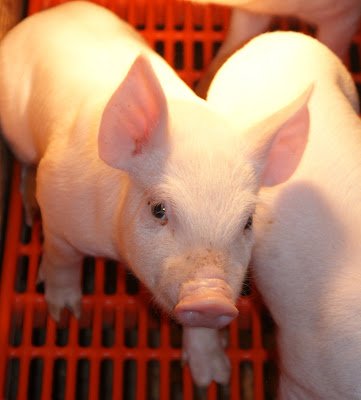The time has come again when I will lose one of my finest ranchers to the harsh business climate of responsibly raised animals. Every few years, a great contributor in our community throws in the towel, and looks for another way to make a living. This leads me to find new producers, and I always learn something more about the choices that farmers and ranchers have to make to grow our food. This took me to Payne Family Farm in Carlton. Mark Payne breeds and raises pigs, which are distributed by Eat Oregon First, a co-operative effort to bring small producers to a larger audience, and keep the work as local as possible.

Mark Payne not only breeds his own pigs, which is a big enough task for a small rancher, but he also grows and mills his own feed. This makes the price of his pork very competitive against the domination of large scale commercial pork. In order to keep it that way, he pens a new mother and her piglets into farrowing crates for several weeks. You can see in the photo the alluminum bars that separate the sleeping sow from her young. Some people think this kind of containment may be cruel, but is it less cruel to leave them on their own. Typically, sows crush up to twenty five percent of their litter, just from rolling over in the middle of the night. Dead piglets are not much use to anyone, and after they are large enough, they are turned into open pens to romp around and suckle as freely as mom allows.
 Thanks for taking the time to show us around the farm and entertain our questions, Mark. We look forward to buying your pigs this year and wish you the best of luck. It's not easy work, but I think you're putting together a strategy that will be local and sustainable, but also affordable, which seems to be one of the most influential factors in people's decision making these days.
Thanks for taking the time to show us around the farm and entertain our questions, Mark. We look forward to buying your pigs this year and wish you the best of luck. It's not easy work, but I think you're putting together a strategy that will be local and sustainable, but also affordable, which seems to be one of the most influential factors in people's decision making these days.
 Thanks for taking the time to show us around the farm and entertain our questions, Mark. We look forward to buying your pigs this year and wish you the best of luck. It's not easy work, but I think you're putting together a strategy that will be local and sustainable, but also affordable, which seems to be one of the most influential factors in people's decision making these days.
Thanks for taking the time to show us around the farm and entertain our questions, Mark. We look forward to buying your pigs this year and wish you the best of luck. It's not easy work, but I think you're putting together a strategy that will be local and sustainable, but also affordable, which seems to be one of the most influential factors in people's decision making these days.
